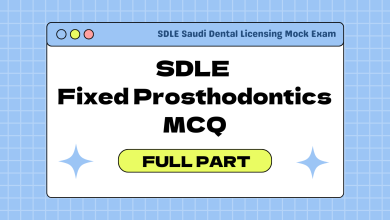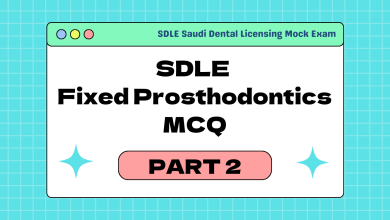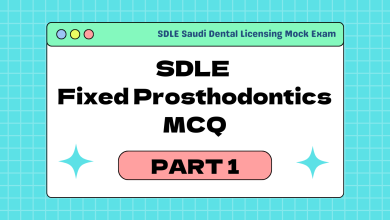Fixed Prosthodontics SDLE MCQ | Part 3

The Ultimate Guide to Conquering the SDLE: Your Strategic Blueprint for Success
Preparing for the SDLE exam is a significant milestone in every aspiring dentist’s career. It’s more than just a test of memorized facts; it’s a comprehensive assessment of your clinical judgment and deep understanding of various dental specialties. Many candidates feel overwhelmed by the vast amount of information, unsure of where to start or how to focus their efforts efficiently.
This in-depth guide is designed to be your roadmap. We will walk you through proven, strategic steps to build a robust study plan, choose the right topics, and approach the exam with the confidence needed to excel.
Part 1: The Art of Smart Topic Selection
One of the most common pitfalls in exam preparation is trying to learn everything at once. A strategic approach to selecting your study topics is not just helpful—it’s crucial for efficient and effective learning.
Why is Topic Selection a Game-Changer?
Your study time is your most valuable resource. Without a clear plan, you can easily spend hours on low-yield information while neglecting the foundational concepts that form the core of the exam. Intelligent topic selection ensures that every hour you invest brings you a higher return in knowledge and exam readiness.
Your Step-by-Step Strategy to Begin:
-
Start with Diagnosis in Every Major Subject.
Before diving deep into complex procedures, ground yourself in the diagnosis for each core specialty: Restorative (Resto), Endodontics (Endo), Prosthodontics (Pros), and Periodontics (Perio). This approach is powerful because it builds critical connections between the subjects. Since most exam questions are clinically-based, understanding how to diagnose a problem is the first and most essential step toward finding the correct solution. You’ll start to see the “big picture” of patient care. -
Identify and Master the Foundational Topics.
Every specialty has a set of fundamental principles that appear again and again. Your initial goal is not to become an expert in every rare condition, but to achieve complete mastery over these core topics. Think of it as building a strong skeleton; once that is in place, you can easily attach more detailed knowledge.
Part 2: Your Detailed Study Blueprint: What to Focus On
The SDLE exam is designed to test your basic knowledge, which means it consistently draws from a predictable set of high-yield topics within each specialty.
A Deep Dive into Key Specialties:
1. Restorative Dentistry
-
Diagnosis: The ICDAS System (International Caries Detection and Assessment System) is paramount. You must know it inside and out.
-
Classifications: Be thoroughly familiar with cavity classifications (Black’s, etc.).
-
Amalgam: Understand its phases, types of failures, and preparation design principles.
-
Partial Coverage: Differentiate clearly between inlays and onlays, including their indications and preparations.
Understanding ICDAS: A Practical Guide
ICDAS provides a standardized method for assessing caries. Here is a clear breakdown:
| Code | Description |
|---|---|
| 0 | Sound tooth surface |
| 1 | First visual change in enamel (seen only after drying) |
| 2 | Distinct visual change in enamel |
| 3 | Localized enamel breakdown without visible dentin |
| 4 | Underlying dark shadow from dentin |
| 5 | Distinct cavity with visible dentin |
| 6 | Extensive distinct cavity with visible dentin |
2. Endodontics
-
Diagnosis: Master pulp testing, percussion, palpation, and radiographic interpretation.
-
Materials: Know the composition, pH, and side effects of key materials like irrigants and sealers.
-
Surgical Procedures: Understand the indications and steps for an apicectomy.
-
Regeneration: Be clear on the indications and materials used in regenerative endodontics.
-
Files: This is a favorite area for examiners. Learn the colors, cross-sections, and specific properties of different file systems, especially hand files like K-files and H-files.
-
Rotary Systems: Understand the basic principles and safety protocols.
3. Periodontics
-
Diagnosis: Be fluent in both the old and new (2017) classification systems for periodontal diseases.
-
Probes: Know the different types of probes and their specific markings.
-
Periodontal Diseases: Understand the etiology and characteristics of gingivitis and various forms of periodontitis.
-
Instruments: Identify and know the uses of scalers, Gracey curettes, and water irrigation systems.
-
Maintenance: Understand the protocols for supportive periodontal care and re-evaluation.
Part 3: Mastering the Question Bank: A Strategic Tool, Not a Crutch
Many candidates use question banks, but few use them optimally. The key is to approach them after you have built a strong foundational knowledge.
How to Truly Leverage Old Questions to Your Advantage:
-
Look for Recurring Patterns. As you go through question sets, you will start to notice that certain topics are tested repeatedly. These are your high-yield areas. Keep a log of these topics and ensure you know them cold.
-
Study the Topic, Not Just the Question. Don’t just memorize the answer to a specific question. When you encounter a question about, for example, “Wharton’s tumor,” don’t just note that the answer is the submandibular gland. Instead, open your textbook and read the entire section on salivary gland tumors. This transforms a single question into a comprehensive learning session.
-
Always Cross-Reference with Reliable Sources. Your primary sources of information should be standard textbooks and current scientific literature. Use the question bank to identify gaps in your knowledge, and then fill those gaps with authoritative material.
-
Take Notes on Every Answer Choice. When reviewing a question, don’t just look at the correct answer. For every incorrect option, write down a brief note explaining why it is wrong. This active learning technique forces you to cover a much broader scope of information and deepens your understanding significantly.
-
Learn from Colleagues. Connect with peers who have recently taken the exam. They can provide valuable insights into the exam’s focus and atmosphere. However, filter this advice—everyone’s experience is subjective.
-
Answer Questions on Your Own First. Resist the temptation to immediately look at the answers. Challenge yourself to reason through the question independently. This builds critical thinking and problem-solving skills that are essential for the exam.
Part 4: Demystifying Exam Difficulty and Building Confidence
It’s natural to feel anxious, especially when you hear stories about “impossible” questions. Let’s reframe that thinking.
Are All the Questions Difficult? Absolutely Not.
Any well-constructed exam has a mix of easy, moderate, and difficult questions. The difficult ones are typically a small percentage, while the bulk of the exam consists of questions of easy to moderate difficulty. The psychological trap is that our brains tend to remember and talk about the challenging questions we faced. This creates a false impression that the entire exam was overwhelmingly hard.
The Takeaway: Don’t let post-exam stories from colleagues panic you. If you find a subject challenging, go back and solidify your basic understanding in that area. A strong foundation will allow you to confidently answer the majority of the questions.
Part 5: Essential Mindset and Final Takeaways for Success
Your preparation isn’t just about intellectual knowledge; it’s also about the right mindset and habits.
Your Success Mantra:
-
Invest Your Time Wisely. The exam is challenging but passable for those who are well-prepared. Consistent, focused study is an investment that will pay off immensely, not just for the exam but for your clinical career.
-
Rethink Study Groups. Avoid using study groups for initial learning. They often become inefficient social sessions. However, they can be excellent for final revision, quizzing each other, and discussing complex topics after you have done your individual studying.
-
Build an Unshakeable Foundation. Prioritize depth over breadth in your core subjects. A deep understanding of fundamental principles will allow you to deduce answers to questions you may not have directly studied.
-
Aim for Mastery, Not Just Passing. Go into the exam with the goal of truly understanding the material. This mindset shift reduces anxiety and fosters a more profound, long-lasting knowledge that will serve you far beyond the exam hall.
Examples of Fixed Prosthodontics SDLE MCQ
1. Category: Fixed Prosthodontics / Impression Materials
Question: What is the maximum recommended time to delay pouring a Polyvinyl Siloxane (PVS) impression to ensure accuracy?
-
A) 1 hour
-
B) 1 day
-
C) 1 week
-
D) 1 month
Correct Answer: 3 (C)
Explanation: PVS impressions are dimensionally stable and can be stored for up to one week before pouring without significant distortion, unlike alginate which requires immediate pouring.
2. Category: Fixed Prosthodontics / Biological Principles
Question: A patient presents with persistent gingival inflammation and bleeding around a well-fitting metal-ceramic crown with a subgingival finish line. What is the most likely cause?
-
A) Allergic reaction to the metal
-
B) Violation of the biological width
-
C) Inadequate oral hygiene
-
D) Occlusal trauma
Correct Answer: 2 (B)
Explanation: Even a well-fitting crown can cause inflammation if its margin is placed too deep, violating the biological width (the combined height of the junctional epithelium and connective tissue attachment). This chronic insult leads to gingival inflammation and bleeding.
3. Category: Fixed Prosthodontics / Treatment Planning
Question: For a young patient who wants the most aesthetic and least invasive prosthesis to replace an avulsed central incisor, which option is most suitable?
-
A) Three-unit fixed dental prosthesis
-
B) Removable partial denture
-
C) Maryland bridge (Resin-Bonded Bridge)
-
D) Immediate implant
Correct Answer: 3 (C)
Explanation: A Maryland bridge is a conservative, aesthetic option that requires minimal tooth preparation on the adjacent abutment teeth, making it ideal for young patients where implant placement might be delayed due to ongoing growth.
4. Category: Fixed Prosthodontics / Materials Science
Question: During the try-in of a Porcelain-Fused-to-Metal (PFM) crown, the ceramic layer fractures and detaches from the metal coping. What is the primary reason for this failure?
-
A) Insufficient occlusal clearance
-
B) Contamination of the metal surface before porcelain application
-
C) Thermal expansion mismatch between metal and porcelain
-
D) Inadequate porcelain thickness
Correct Answer: 2 (B)
Explanation: The bond between porcelain and metal is primarily mechanical. Any contamination (e.g., oils, saliva, dust) on the metal coping before porcelain application will prevent a proper bond, leading to adhesive failure.
5. Category: Fixed Prosthodontics / Pontic Design
Question: Which pontic design is considered the most difficult for the patient to clean effectively due to its close adaptation to the ridge?
-
A) Ovate
-
B) Sanitary
-
C) Ridge Lap
-
D) Modified Ridge Lap
Correct Answer: 3 (C)
Explanation: The ridge lap design has a large, concave area that contacts the edentulous ridge, creating a plaque-retentive area that is very difficult for the patient to clean, often leading to inflammation.
6. Category: Fixed Prosthodontics / Dental Ceramics
Question: If a dental technician adds an extra layer of a very opaque, white porcelain block to mask a dark tooth stump, what other adjustment should they make to maintain natural aesthetics?
-
A) Increase the firing temperature
-
B) Increase the overall translucency of the crown
-
C) Increase the thickness of the crown
-
D) Add more characterized stains
Correct Answer: 2 (B)
Explanation: Highly opaque layers can make a crown look chalky and lifeless. To compensate and achieve vitality, the technician should balance the opacity by building the incisal and proximal areas with more translucent porcelain.
7. Category: Fixed Prosthodontics / Crown Cementation
Question: Immediately after cementing a crown, a 1mm open margin is discovered on the buccal surface that was not visible during the try-in. What is the most appropriate course of action?
-
A) Fill the gap with flowable composite resin
-
B) Dismiss the patient and monitor
-
C) Attempt to remove the crown, clean it, and re-cement it
-
D) Schedule the patient for a new crown fabrication
Correct Answer: 4 (D)
Explanation: An open margin discovered after cementation is likely a fabrication error in the crown itself. Removal often damages the crown, and re-cementation won’t correct the underlying defect. The correct long-term solution is to remake the crown.
8. Category: Fixed Prosthodontics / Tooth Preparation
Question: What is the recommended amount of facial reduction for a metal-ceramic crown on an anterior tooth to provide adequate space for both strength and aesthetics?
-
A) 1.0 mm
-
B) 1.5 mm
-
C) 2.0 mm
-
D) 0.5 mm
Correct Answer: 2 (B)
Explanation: A reduction of 1.5 mm on the facial surface allows for a sufficient metal coping thickness (0.3-0.5 mm) and an aesthetic thickness of porcelain (1.0-1.2 mm) to achieve proper color and characterization.
9. Category: Fixed Prosthodontics / Color Science
Question: In dental shade matching, the term “Value” refers to what property of color?
-
A) The hue or family of the color (e.g., red, yellow)
-
B) The lightness or darkness of the color
-
C) The intensity or saturation of the color
-
D) The translucency of the material
Correct Answer: 2 (B)
Explanation: In the Munsell color system, which dentistry uses, “Value” specifically describes how light or dark a color is. It is the most critical dimension to match for a restoration to appear natural.
10. Category: Fixed Prosthodontics / Periodontal-Prosthetic Interface
Question: A patient has a tooth requiring a crown, but only 1mm of sound tooth structure is visible above the gingiva, and the biological width is measured at 1.5mm. What is the correct treatment sequence?
-
A) Place a post, then a crown, then perform crown lengthening
-
B) Perform crown lengthening, then place a post and crown
-
C) Place a post, perform crown lengthening, then place the crown
-
D) Place the crown subgingivally and monitor
Correct Answer: 3 (C)
Explanation: The ferrule effect requires 2mm of sound tooth structure. With only 1mm visible, surgical crown lengthening must be performed first to expose more tooth structure and respect the biological width. A post can be placed after endodontic therapy, followed by the final crown on the newly lengthened tooth.
Conclusion: Your Journey to Success Starts Now
The path to SDLE success is a marathon, not a sprint. It requires careful planning, disciplined execution, and a positive, resilient mindset. Start by strategically selecting your topics, build your knowledge layer by layer, and use practice questions as a diagnostic tool to refine your understanding.
Remember, confidence is born from competence. Every well-understood topic, every mastered concept, and every strategically studied hour brings you closer to your goal.
You have the capability and the resources to excel. Trust your preparation, stay focused on your plan, and walk into the exam ready to demonstrate your knowledge. Good luck





